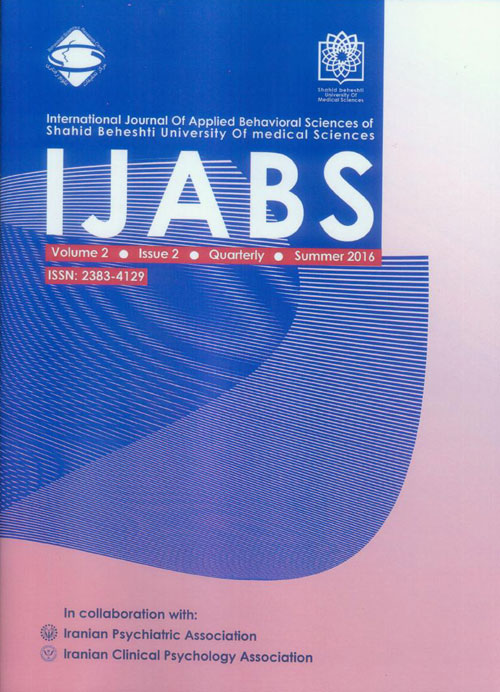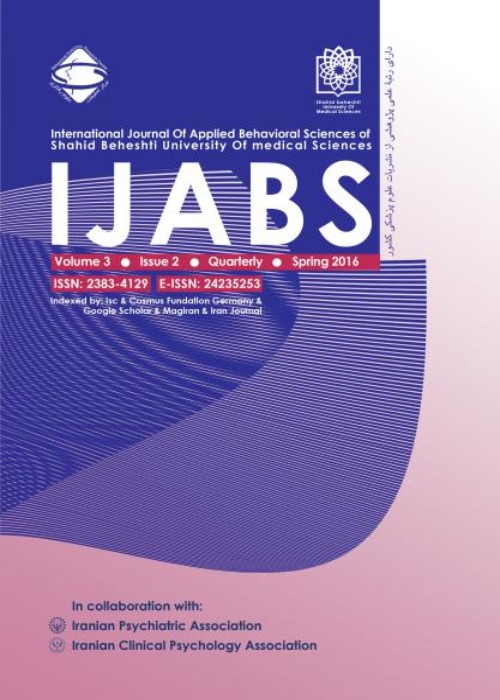فهرست مطالب

International Journal of Applied Behavioral Sciences
Volume:2 Issue: 3, Summer 2015
- 52 صفحه،
- تاریخ انتشار: 1394/11/20
- تعداد عناوین: 7
-
-
The Association between functional-emotional development and creative thinking in preschool childrenPages 1-7The present study aims to investigate the association between emotional-functional development and formation of creative thinking among children of 4-6 years old in Mashhad City. To do this, 80 children and their mothers were selected from preschools of Mashhad City based on cluster sampling method. The level of creativity among children was measured through Torrance test of critical thinking (TTCT: visual B-form). The mothers of children in sample group answered the Greenspan inventory of functional-emotional growth inventory. Data analysis showed a significantly positive association between functional-emotional growth and aspects of fluidity, expansion and innovation in two groups of male and female preschool children as verified in creativity test. The results of simple linear regression analysis also showed that functional-emotional growth can predict 0.05 percent of variance in creativity. Based on the results of t-test for independent groups, there was no significant different in the level of functional-emotional growth and creative thinking among male and female preschool students. The findings of present study supports the theory of Greenspan (1997) regarding the significance of functional-emotional growth in integrated growth of human kind and emergence of higher levels of thinking.
-
Pages 8-14To study the effect of positive psychology intervention on psychological well-being of drugs inmates.The subjects were 30 male drugs inmates in Semnan prison. The participants were selected through random sampling and randomly placed in experimental (15 person) and control groups (15 person). One person in control group was absent in post-test. Experimental and control group answered to psychological well-being scale before starting intervention. Experimental group received positive psychology intervention during 12 sessions. After 12 sessions, all participants (control and experimental group) were assessed by the scale of study. Data collated was analyzed using multiple analysis of variance procedure.The statistic analysis showed the mean psychological well-being of the experimental testes was meaningfully higher than the mean of psychological well-being of the control group testes.
-
Pages 15-21IntroductionThe purpose of this study was to examine and compare the social adjustment in balanced and non-balanced patterns of the parent-child relationship.MethodsThe research population was all female gifted students in the Farzanegan high school in the first educational district of Tehran in 2013-14. The sample research included 96 female gifted students who answered the parent-child relationship model questionnaire and the social adjustment subscale of the Bell adjustment inventory. After scoring their responses and removing uncompleted ones, Sample population was divided into three groups of: the balanced, the non-balances liberal based, and the non-balanced secure-based patterns of parent-child relationship. Data were analyzed by the SPSS using one-way ANOVA.ResultsThe results showed that the mother-child pattern of the relationship influenced on the child’s social adjustment, while there was no significant influence for the father-child pattern of the relationship.ConclusionIt should be taken into account that the results of this study shows the social adjustment in young ages and before being independent from the family, but the secure-based pattern essentially does not train individuals with high social adjustment.Keywords: social adjustment, parent, child relationship model (balanced pattern, liberal, based pattern, secure, based pattern)
-
Pages 22-28IntroductionTardive dyskinesia is one of the major side effects of long-term neuroleptic treatment. Increased reactive oxygen species and oxidative stress has been proposed as possible etiopathologic mechanisms. Ginkgo biloba extract (EGB) is a natural antioxidant. We investigated the effects of ginkgo biloba extract on neuroleptic-induced orofacial dyskinesia in rats, a potential animal model for tardive dyskinesia.MethodsOrofacial dyskinesia was induced by chronic administration of haloperidol (1 mg/kg i.p) for a period of 21 days. On 22nd day, animals were assessed for development of oral dyskinesia. Malon di aldehyde (MDA), glutathione (GSH), superoxide dismutase (SOD) and catalase levels were evaluated in animal forebrain homogenate.ResultsChronic haloperidol (1 mg/kg) treatment significantly increased the vacuous chewing movement’s frequency, increased MDA and decreased SOD and catalase levels. Co-administration of EGB 25 mg/kg along with haloperidol suppressed the haloperidol induced vacuous chewing movements (Pvalue < 0.05). EGB 100 mg/kg reversed haloperidol induced reduction in SOD level. It also reversed the increment in MDA level observed in haloperidol treated rats.ConclusionThe present study suggested that oxidative stress plays a significant role in neuroleptic-induced orofacial dyskinesia and EGB co-administration reverses these behavioral and biochemical changes.Keywords: Movement Disorders, Neuroleptics, Gingo Biloba, Dyskinesia, Psychomotor Disorders
-
Methamphetamine abuse in former opiates addicts currently in methadone maintenance treatment in IranPages 29-34BackgroundTo measure suspected abuse of the methamphetamine (MA) among methadone maintenance treatment (MMT) patients in Tehran, we studied all 206 patients who were admitted to MMT program from 2009 to 2015 to Andishe-No addiction treatment clinic.MethodsMA presence was screened in one of the random urine samples routinely taken for tests of other drugs.Results70 (34.3%) patients were positive for MA. A logistic regression (multivariate analyses) demonstrated that the MA abusers were more likely to be opiate abusers and less likely to be married.ConclusionThe high prevalence of MA abuse found in our patients which was rather higher than the rate of MA abuse before treatment entrance. The high rate of MA abuse in Iran needs future study.
-
Pages 35-41The Aims This ready project has done to determine relationship between mother,s personality traits with perfectionism and academic procrastination in first grade of high school girl students. Group of studying in this search involve all girl student who studied in first grade of high school in Robatkarim city.Methodthis sample chose base on science contained 200 person by simple random sampling method. For collecting data has used of NEO five factor inventory (short form)and Solomon & Roth Blum academic procrastination scale and frost perfectionism scale.FindingThis project is type of correlation. For data analyze has used describing statistic and perennial statistic person correlation and multi variable Regression step by step and was used result showed:There is significant positive correlation betweenacademicprocrastinationandmother(neuroticism)andnegativecorrelationwith(extraversion,openness,agreeableness,consciententiousness).also analyze regression showed that mother,s conscientiousness, agreeableness, openness are suitable predictor for academic procrastination.ConclusionSom of the mother, personality traits,are predictors for perfectionism & girl,s academic procrastination. This subject confirm more than before intending parent-filial,s relationship interaction, especially Mother in shape som behavioral characteristics.
-
Pages 42-51IntroductionThe consequences of the increasing use of the Internet for young people have became of interest for researchers in the field of sociology and psychology. The purpose of this study was to determine the role of parental acceptance, rejection, and control in Internet addiction of female students. The study population consisted of all female students of Shahid Beheshti University in Tehran.MethodsIn which 262 individuals with a mean age of 24 years were selected in multi-stage cluster sampling. The method of study was descriptive and correlative type and questionnaires of "Internet Addiction Test (IAT)" and "scale of Parental Acceptance, Rejection and Control Questionnaire (PARCQ)" were used to collect data. Data analysis was performed using Pearson's correlation and regression analysis.ResultsResults showed that the components of rejection, anger and ignorance of parents have a significant relationship with Internet addiction and there is an inverse significant relationship between the components of the acceptance and Internet addiction. However, no significant relationship was found between parental control and Internet addiction. The regression analysis showed that the variable of parental acceptance and ignorance has the most predictive role in girl's Internet addiction and paternal and maternal control component has no explanatory role in this model.ConclusionThe results showed that parenting style and parent-child interaction play an important roles in addictive tendencies of girls to the internet and we can use this component in prevention and intervention programs in this area.Keywords: parental acceptance, parental rejection, parental control, Internet addiction, Female college students


